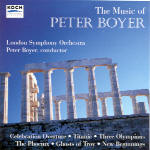American composer Peter Boyer (b. 1970) made a (musical) splash for himself with his symphonic poem Titanic, which preceded the film by several years but offers in about 13 minutes what takes James Cameron three hours and 10. It begins with a portrait of the hostile sea, characterizes the ship and passengers with music evocative of the period (including “Alexander’s Rag Time Band”), hits the iceberg with the obligatory percussive crash, then sinks to an ominous passacaglia punctuated by the strains of “Nearer My God to Thee”, which according to legend was played by those now famous musicians who accompanied the vessel’s final moments. A ghostly reminder of all of the previous tunes, simultaneously layered, makes a fitting coda both programmatically and musically.
The most impressive thing about this work is the manner in which Boyer has found musical analogs to the actual events being depicted so as to give the piece a form and substance independent of its purely descriptive aspects, a quality shared by all good program music. For example, the final passacaglia admirably conveys the inexorability and terror of the ship sinking without the necessity for graphic instrumental explosions, downward scales, glissandos, or other “cheap” effects. That’s something Boyer should keep in mind because the other works on this disc aren’t wholly free of such things.
Consider for example the two overtures, Celebration and New Beginnings, occasional pieces of a deliberately popular cast. Now none of Boyer’s music moves much beyond traditional harmony and melody, and he’s clearly learned a great deal about orchestration from his teacher John Corigliano and from the film composers he professes to admire (Jerry Goldsmith especially). But being “traditional” doesn’t mean that you have to be obvious, as in the final return of the Big Tune at the end of New Beginnings (more than a hint of Goldsmith here–perhaps the lyrical central section of Capricorn One’s overture, or a bit of The Blue Max), where the suspended cymbal rolls add a touch of cheesy glitz that the music really doesn’t need. Rippling celesta passages, shimmering wind chimes, and decorating a lyrical tune with glockenspiel and other bell sounds always makes an appropriate effect, but these devices also give the music a ready-made, manufactured quality–a sonic sameness that rapidly palls. Anyway, that’s my two-cents’ worth.
This observation aside, it’s smooth sailing as far as the remaining works go. All three deal with the mythological subjects near and dear to Boyer’s heart. The Phoenix does what its title implies: flies around, burns up, dies, and gets reborn. It’s a marvelous musical subject and Boyer has captured its essence colorfully and concisely. Ghosts of Troy has something of the starkness of Barber’s Medea ballet, its six short, linked movements also paying tribute to Goldsmith’s score to Planet of the Apes (compare “The death of Patroclus” to Goldsmith’s cue “The Clothes Snatchers”). Three Olympians (as in Greek gods, not sports figures) just might be the most impressive work here, both for the sonorous inventiveness of its strings-only scoring, with “modernistic” and textural effects such as snap pizzicatos, harmonics, and glissandos perfectly integrated into Boyer’s own tonal idiom, as well as for the distinction of its tunes, especially the lovely one in the central movement depicting Aphrodite.
The performances under the composer’s own direction sound suitably confident, though I think a little more session time would have given Boyer the opportunity to achieve additional precision in the 7/8 and 10/8 concluding sections of New Beginnings, as well as to inject a touch more fleetness at that same point. Sonically the recording has great transparency and presence, but a definite “studio” atmosphere, meaning a dryness that denies the bass maximum amplitude and a lack of reverb that tends to make the trumpets sound a bit tinny. Boyer is, without question, a serious talent and a composer to watch. At this early date it’s impossible to define his personal “style” with any specificity, nor is it necessary. All we need to do now is sit back and enjoy, and the music on offer here certainly invites you to do just that.
































